May 2019 LIP of the Month
Soltan Maidan Basaltic Complex (SMBC), northern Iran: Implications for Late Ordovician-Early Late Silurian magmatism along the northern margin of Gondwana
Morteza Derakhshi1, Habibollah Ghasemi2, Laicheng Miao3
1 Department of Geology, Urmia Branch, Islamic Azad University, Urmia, Iran
e-mail: mortezaderakhshi78@yahoo.com
2 Faculty of Earth Science, Shahrood University of Technology, Shahrood, Iran
3 Institute of Geology and Geophysics, Chinese Academy of Sciences, Beijing, China
This summary is mainly extracted and modified from: Derakhshi, M., Ghasemi, H., Miao, L. (2017). Geochemistry and petrogenesis of Soltan Maidan basalts (E Alborz, Iran): Implications for asthenosphere-lithosphere interaction and rifting along the N margin of Gondwana. Chemie der Erde. 77, 131-145. Moreover, some diagrams or pictures are from: Derakhshi & Ghasemi (2014) and Derakhshi & Ghasemi (2015).
Introduction and background information
Soltan Maidan Basaltic Complex (SMBC) with thickness up to about 1300 m and Late Ordovician-Early Late Silurian age is located in the eastern Alborz zone, north of Iran (Figs. 1 and 2). It represents the most important, thick and voluminous Lower Paleozoic volcanic activity in Iran. The thickness of this complex varies from 436 to 1286 m and is dominantly comprised of transitional to mildly alkaline basaltic lava flows, agglomerates and tuffs, which are associated with a few sedimentary interlayers of shale, siltstone, sandstone and conglomerate (Figs. 2 and 3).
We studied three main outcrops of the SMBC, including (a) Kaludar Valley (b) Cheshmeh-Seyed Valley and (c) around the village of Khoshyeilaq, which are located in the northwest, north and northeast of Shahrud city, respectively (Figs. 1-3). Moreover, we present a set of whole-rock geochemical and isotopic data for Soltan Maidan basalts and biostratigraphic (palynological) age of the sedimentary interlayers of SMBC. Using these data, we evaluate the nature of the mantle source, the role of asthenosphere-lithosphere interaction in the origin of the Soltan Maidan volcanic rocks, and also age of the complex and its relationship with the Paleotethys evolution.
The best and most complete outcrop of the SMBC in the study area, with at least 50 basaltic lava flows, has been identified in the Cheshmeh-Seyed Valley. Field geological evidence indicated that this complex was accumulated in both subaerial and submarine environments. The marine environment is supported by pillow lavas and intercalated green shale-siltstone layers. However, columnar joints (Fig. 4), red sandstones, and existence of intercalated granitic conglomerates in different outcrops show some parts of SMBC were formed in a subaerial environment. This evidence shows instability and vertical movements of the study area at the time. In addition, the presence of a conglomerate unit with thickness up to 7 m in the upper parts of SMBC containing enormous rounded pink granitic clasts (Fig. 5) indicates bimodal character of Soltan Maidan magmatism. The presence of these granitic clasts provides a good signature for intense vertical movements and unroofing of granites during the accumulation of SMBC.
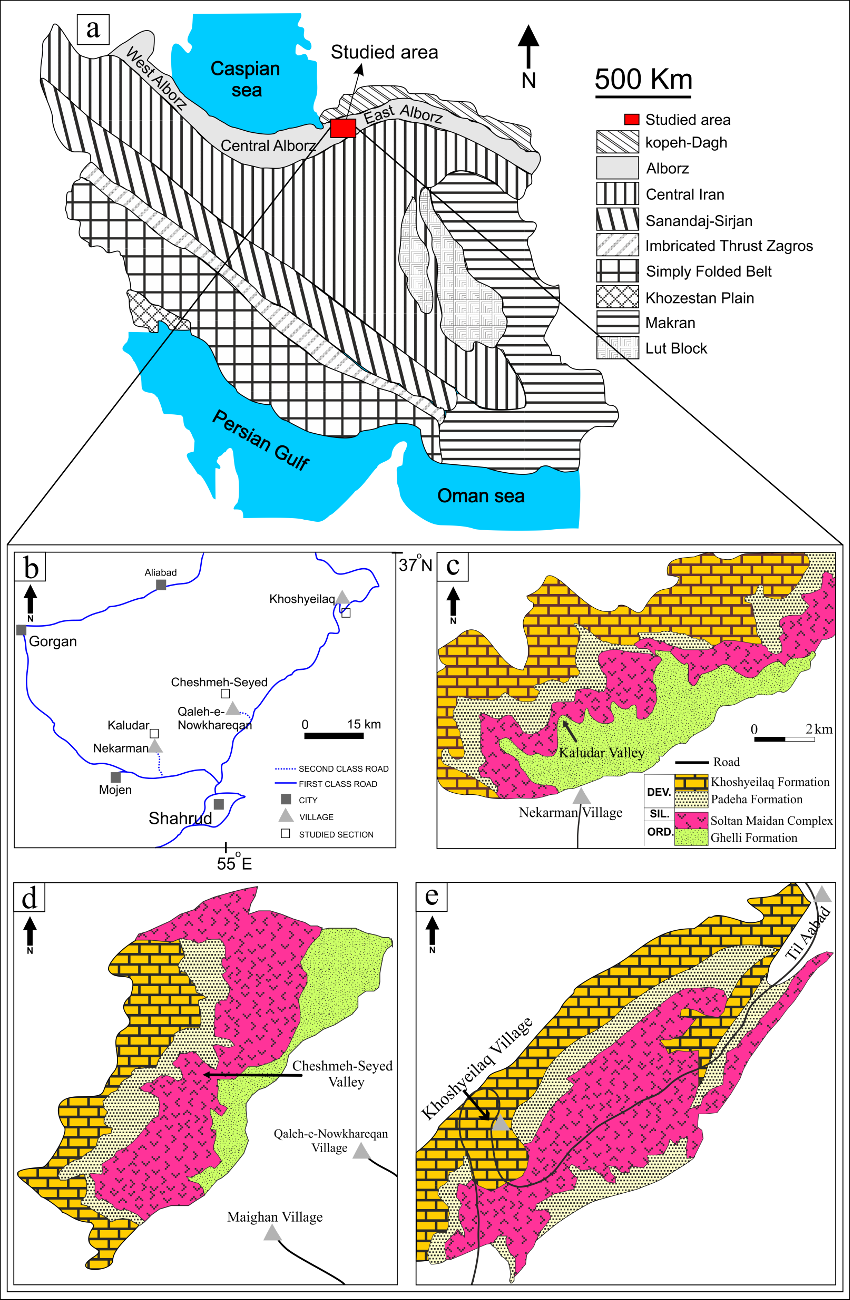
Fig. 1. (a) Geological-structural map and major tectonic divisions of Iran (modified from Stocklin, 1968); (b) Sketch geographic map and location of studied sections; Simplified geological maps of main outcrops of the SMBC: (c) in the Kaludar Valley (d) in the Cheshmeh-Seyed Valley and (e) around the village of Khoshyeilaq.
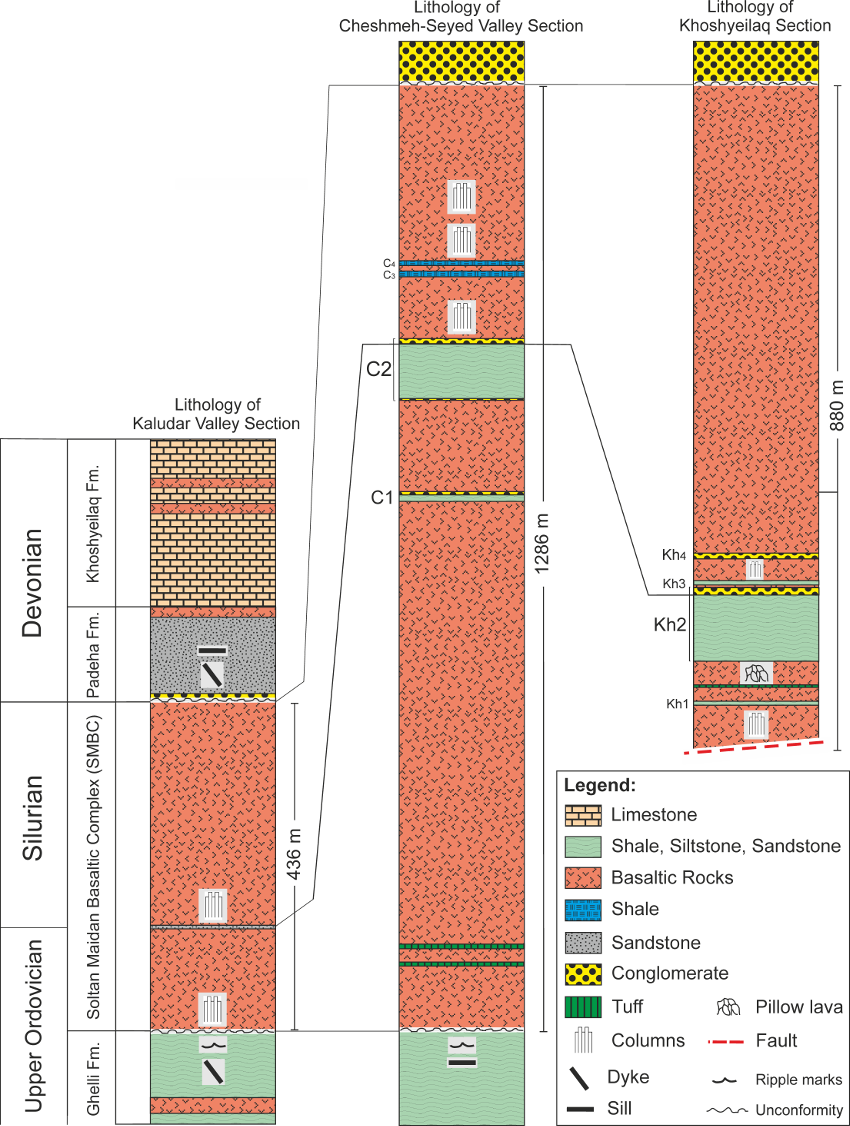
Fig. 2. Stratigraphic sections of the SMBC, upper part of Ghelli Formation and lower part of Padeha Formation in the Kaludar Valley, Cheshmeh-Seyed Valley, and Khoshyeilaq area.
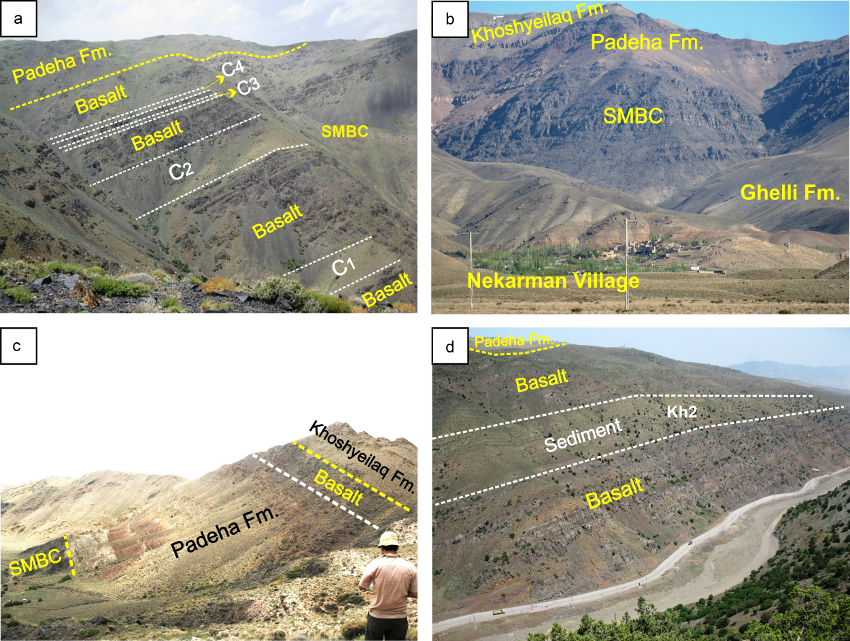
Fig. 3. General views of SMBC in the (a) Cheshmeh-Seyed Valley (b) Kaludar Valley (d) Khoshyeilaq area. Moreover, (c) shows the uppermost part of SMBC which is disconformably overlain by the Padeha Formation (belongs to the Early-Middle Devonian) in the west of Cheshmeh-Seyed Valley.
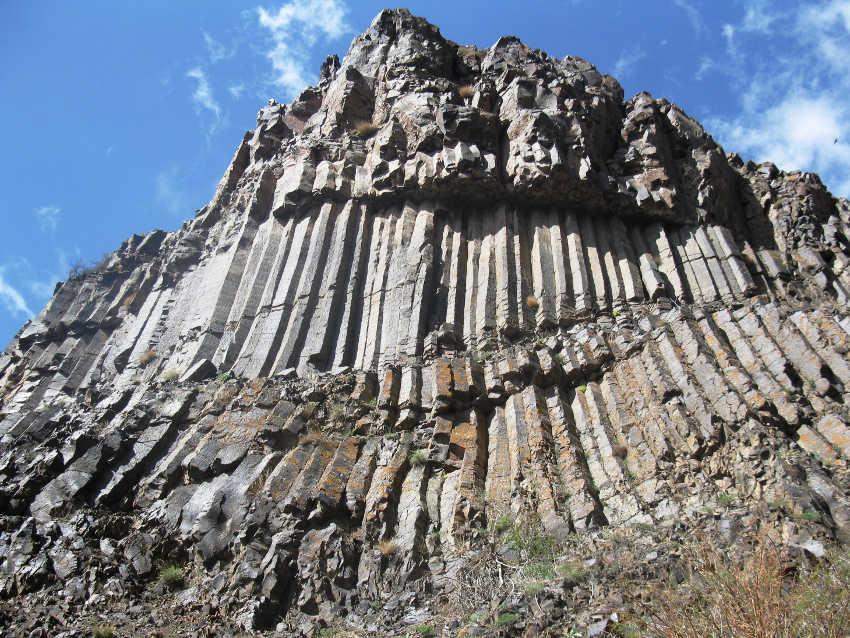
Fig. 4. Well-developed columnar joints at the base of SMBC in the Kaludar Valley.
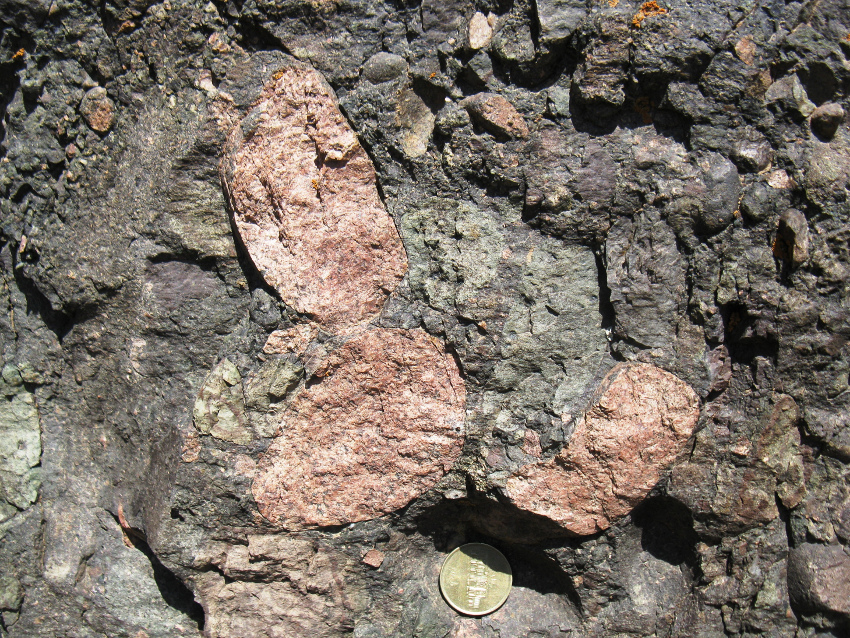
Fig. 5. Close up view of a conglomerate with rounded pink granitic clasts within the SMBC in the Khoshyeilaq section.
Petrography
Soltan Maidan basalts are generally uniform in petrographic composition and display moderate to high degrees of alteration. Labradorite plagioclase (up to 25%) and augite (up to 10%) are present as phenocrysts and also the groundmass is mainly composed of plagioclase, augite, altered glass, and Fe-Ti oxides (Fig. 6). In addition, olivine that is completely replaced by secondary minerals is present in a few samples. Moreover, electron microprobe analyses (EMPA) of plagioclases by Derakhshi et al. (2015) indicated extensive albitization and replacement of labradorite by albite. The Fe-Ti oxides in the investigated rocks include magnetite, ilmenite and titanomagnetite in decreasing order of abundance.
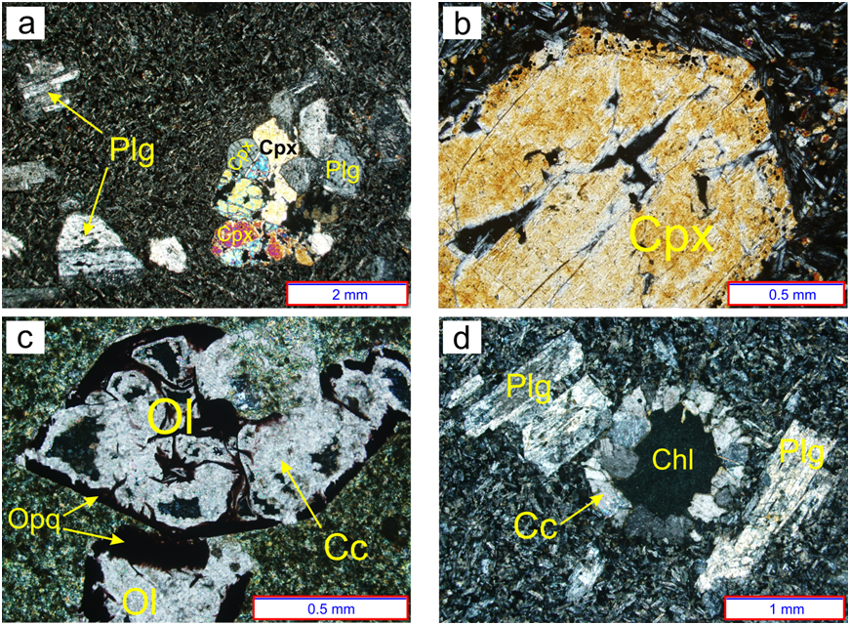
Fig. 6. Photomicrographs of thin sections of Soltan Maidan basalts under cross polarized light. (a) Porphyritic texture and glomeroporphyritic cluster of clinopyroxene (Cpx) and plagioclase (Plg) crystals in the fine-grained plagioclase and opaque (Opq) groundmass. (b) A large clinopyroxene (augite) phenocryst in a groundmass of plagioclase and clinopyroxene (augite). (c) Subhedral phenocrysts of olivine (Ol) are entirely replaced by calcite (Cc) and opaque minerals. (d) Amygdaloidal texture. Infilling minerals are calcite and chlorite.
Biostratigraphy
The SMBC overlies the Upper Ordovician Ghelli Formation and is disconformably overlain by the Padeha Formation belong to the Early-Middle Devonian. Study of Ghelli Formation by Ghavidel-Syooki et al. (2011) has showed a relatively shallow marine, platformal depositional environment and a ‘North Gondwana Domain’ affinity for this formation during the Late Ordovician.
Because of the presence of a complete exposure of the SMBC in the Cheshmeh-Seyed Valley section, we have examined the palynomorph assemblages in the sedimentary interlayers to determine the age of the complex. Palynological studies were carried out with the aid of Prof. Mohammad Ghavidel-Syooki on six surface samples from the shale units of the C1 and C2 (see Figs. 2 and 3); slides pertaining to this study were prepared in the palynology laboratory of the Geological Survey of Iran, and the National Iranian Oil Company, Tehran. In general, most samples contain well-preserved and abundant palynomorph taxa, including acritarchs, miospores, scolecodonts, and chitinozoans.
As a result, based on the palynomorph assemblages (Fig. 7a-l) in the shale units of the C1 and C2, a Late Ordovician (Hirnantian) age is assigned to these two interlayers. We have also used some data from Ghavidel-Syooki et al. (2011) for correlation and to determine the age of palynomorph assemblages in the shale units of the C3 and C4 (see Figs. 2 and 3). Their results on the equivalent shale units with C3 and C4 in the Khoshyeilaq area (i.e. Kh3 and Kh4 interlayers) has indicated typical middle Silurian forms of acritarch assemblages, and they indicate that SMBC is not younger than Gorstian (early Ludlow, early late Silurian). Hence, the combination of our results with those described by Ghavidel-Syooki et al. (2011) indicates Late Ordovician to Early Late Silurian ages for SMBC.
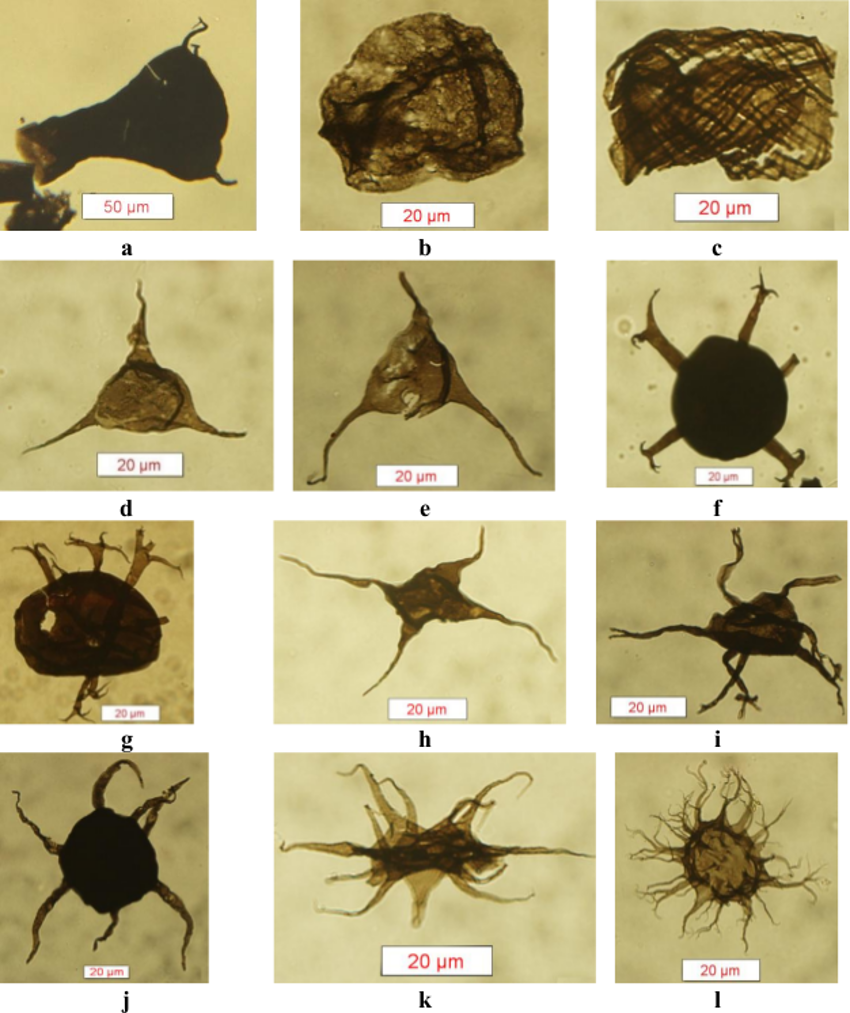
Fig. 7. Some of the identified palynomorphs in the sedimentary interlayers (C1 and C2 shale units, see Figs. 2 and 3) of SMBC in the Cheshmeh-Seyed Valley section. Palynomorph assemblages in these shale units indicate a Late Ordovician age for middle and lower parts of the SMBC. (a) Ancyrochitina merga (b) Leiosphaeridia sp. (c) Dactylofusa cabottii (d) Veryhachium reductum (e) Veryhachium trispinosum (f & g) Ordovicidium elegantulum (h) Veryhachium lairdii group (i) Diexallophasis denticulate (j) Baltisphaeridium perclarum (k) Multiplicisphaeridium bifurcatum (l) Multiplicisphaeridium irregular.
Geochemical and isotopic signatures
Soltan Maidan volcanic rocks have a relatively wide compositional range in major oxides: SiO2=46.7-55.2 wt% (average=50.1 wt%), Fe2O3(t)=8.38-14.9 wt%, MgO=2.8-10.1 wt% (average=5.4 wt%), CaO=4.01-9.43 wt%, Al2O3=12.4-16.3 wt%, TiO2=1.61-3.34 wt%, P2O5=0.16-0.48 wt% and K2O+Na2O from 2.43 to 6.54 wt%.
All of the basaltic samples are plotting in subalkaline-alkaline basaltic fields and mostly near the boundary line between them (Fig. 8). Moreover, variations of La/Lu ratios versus La (Fig. 9) indicate variations in degrees of partial melting in the source. Indeed, variations in degrees of partial melting and subsequent fractional crystallization of melt have led to the transitional
to mildly alkaline nature of the magma. Moreover, clinopyroxene-melt thermobarometry by Derakhshi et al. (2015) indicated that magmatic fractionation took place in the shallow magma chamber(s).
Chondrite- and primitive-mantle normalized multi-element patterns of Soltan Maidan basalts (Fig. 10) demonstrate enrichment in highly incompatible elements relative to less incompatible ones and their patterns are most similar to OIB.
In addition, trace elemental and Sr-Nd isotopic compositions (Fig. 11) indicate interaction and mixing of asthenospheric mantle source (OIB-type) with enriched subcontinental lithospheric mantle components (EM1-type) in an extensional tectonic setting.
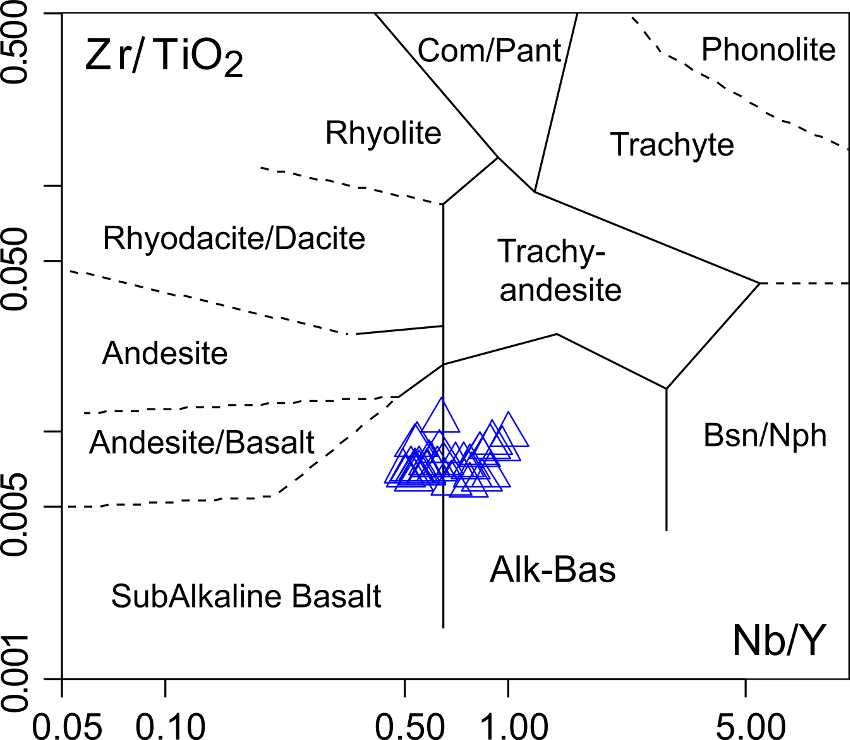
Fig. 8. Classification of Soltan Maidan volcanic rocks in terms of Zr/TiO2 versus Nb/Y (after Winchester and Floyd, 1977). As shown, samples mostly plot near the boundary line dividing alkaline and subalkaline basalts.
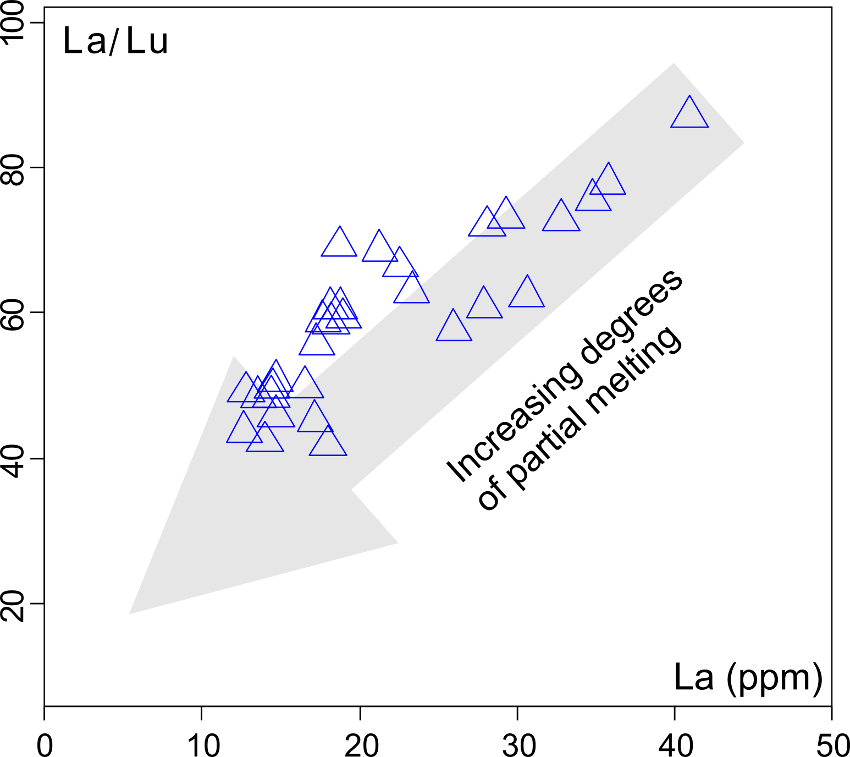
Fig. 9. Plot of La/Lu versus La (after Lustrino et al., 2002) illustrate variations in degrees of partial melting in the source.
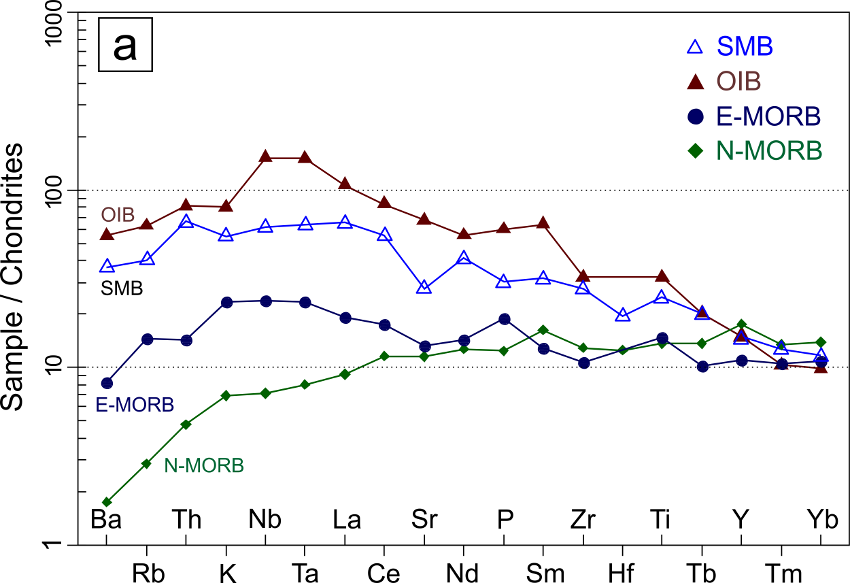
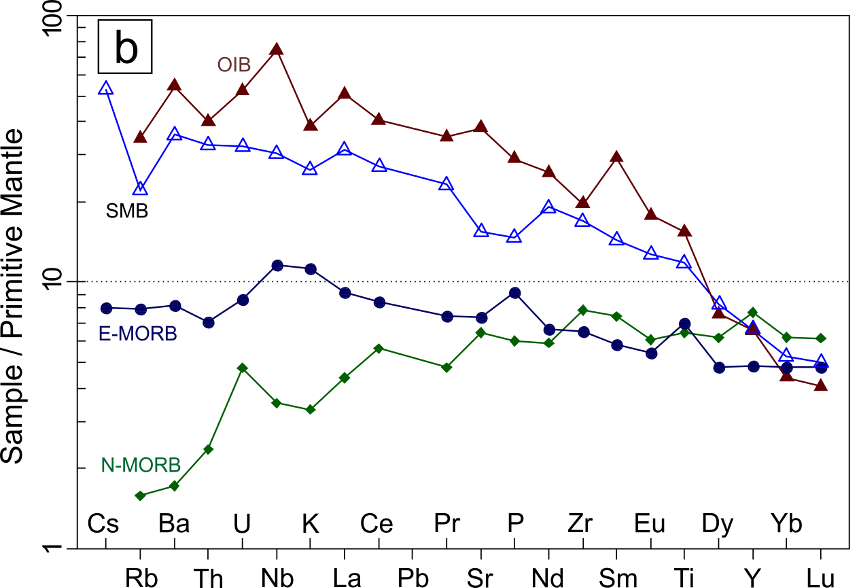
Fig. 10. (a) Chondrite- and (b) primitive-mantle normalized multi-element patterns of Soltan Maidan basaltic samples, OIB, E-MORB and N-MORB for comparison. Note that the sample patterns are more similar to the patterns of OIB. Chondrite values are from Thompson (1982), and primitive-mantle values from Sun and McDonough (1989). OIB data are after Sun (1980); Sun and McDonough (1989), E-MORB from Sun and McDonough (1989), and N-MORB values are from Sun (1980); and Saunders and Tarney (1984).
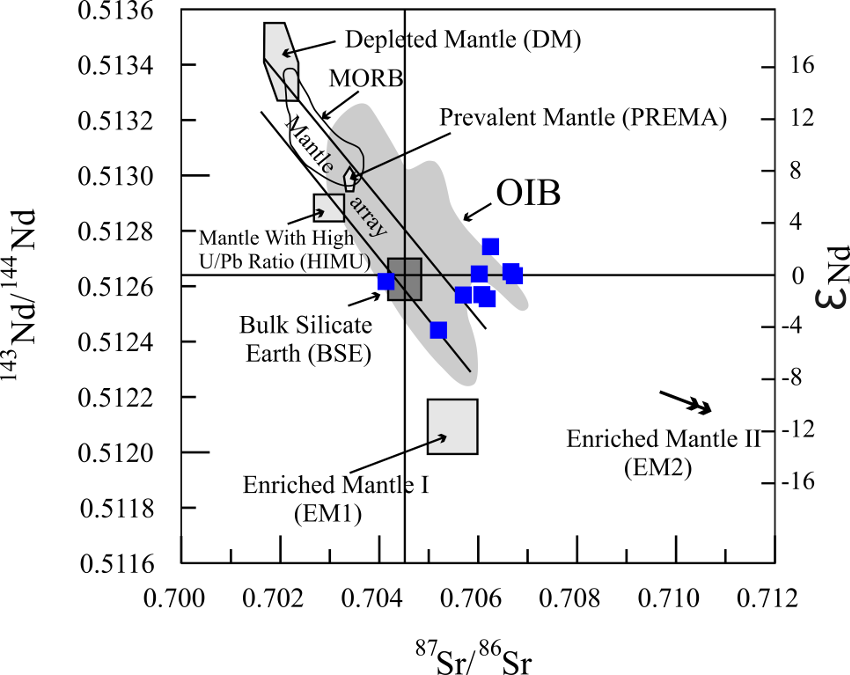
Fig. 11. 143Nd/144Nd versus 87Sr/86Sr diagram for the Soltan Maidan basalts. The fields of DM, MORB, HIMU, PREMA, BSE, OIB, EM1 and EM2 are from Zindler and Hart (1986).
Tectono-magmatic model
Soltan Maidan volcanism with more than 1000 m of lava flows have resulted from a within- plate (continental rift) setting (Fig. 12) near the Paleotethys suture zone. This is the most important and voluminous magmatic event in the Alborz structural zone which corresponds closely to continental rifting of Paleotethys at the time.
In Fig. 13, we present a tectono-magmatic model for the Late Ordovician to Middle Devonian time in the study area. As has been shown earlier, palynomorph assemblages in the sedimentary interlayers indicate that the onset of the volcanic activity occurred in the Late Ordovician time and lasted to the Early Late Silurian. During this period of time, the studied area and other parts of Alborz zone were dominated by an extensional tectonic regime. The transitional to mildly alkaline nature of samples may also show intense crustal thinning in the area, where decompression can take place and explain the Lower Paleozoic volcanic activity in the SMBC as well as the geochemical characteristics.
The presence of an erosional surface at the top of the SMBC overlaid by sandstones and conglomerates of Padeha Formation (belonging to Early-Middle Devonian) as a disconformity shows that volcanic activity probably continued after the Early Late Silurian. It seems that the continental breakup and opening of Paleotethys should have taken place after the end of Soltan Maidan volcanism and synchronous or after the erosional event at the top of the SMBC.
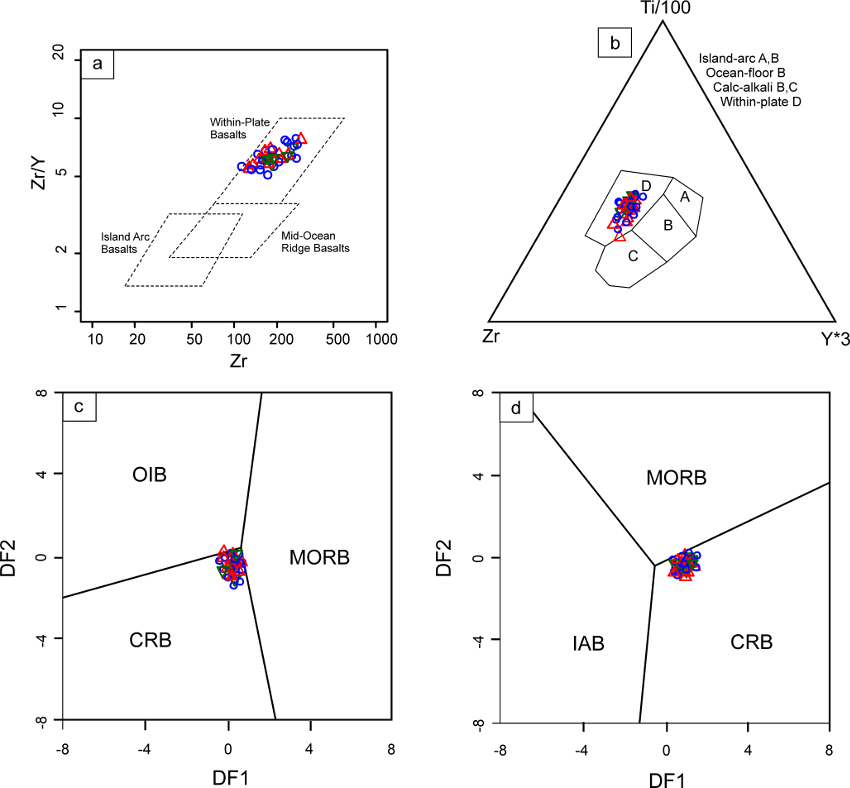
Fig. 12. Tectonomagmatic discrimination diagrams for Soltan Maidan volcanic samples. These diagrams show a within-plate and continental rift setting for the studied samples. (a) Zr/Y-Zr diagram is after Pearce and Norry (1979), (b) Ti-Zr-Y diagram is after Pearce and Cann (1973), (c) and (d) La, Sm, Yb, Nb, and Th diagram is after Agrawal et al. (2008).
MORB: mid-ocean ridge basalt, IAB: island arc basalt, CRB: continental rift basalt, OIB: ocean-island basalt.
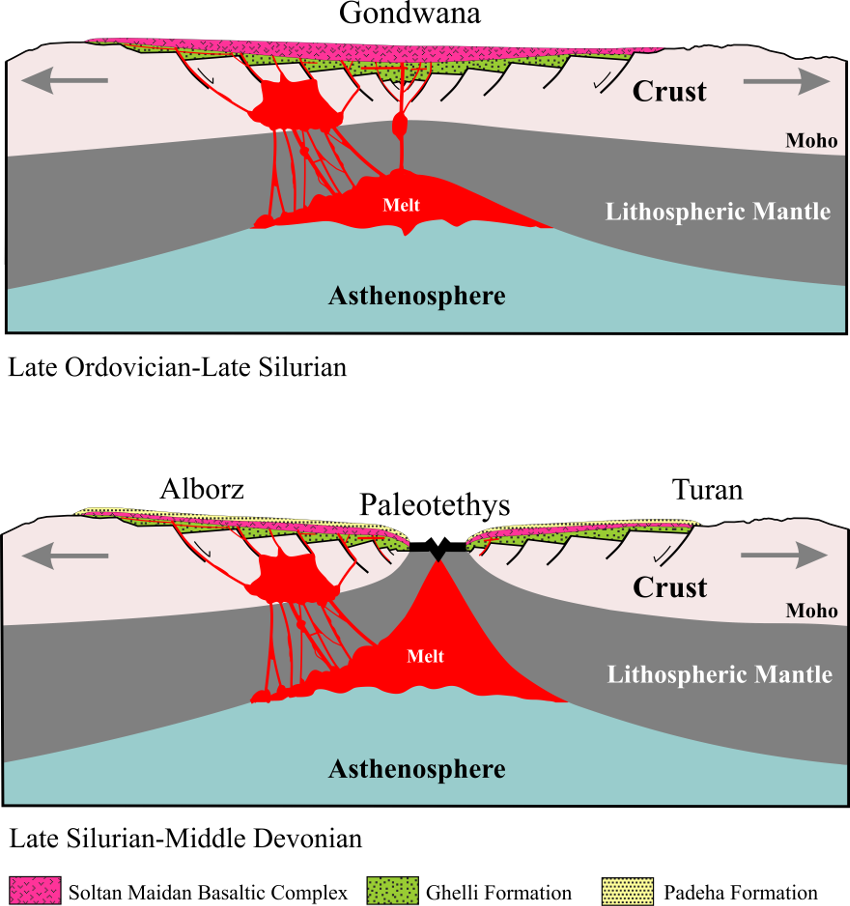
Fig. 13. Schematic tectono-magmatic model of the study area during the Late Ordovician to Middle Devonian time.
Click to open/close ReferencesReferences
Agrawal, S., Guevara, M., Verma, S. P. (2008). Tectonic discrimination of basic and ultrabasic volcanic rocks through log-transformed ratios of immobile trace elements. Int Geol Rev. 50, 1057-1079.
Derakhshi, M., Ghasemi, H. (2014). Ordovician-Devonian magmatism in the north of Shahrood: implication for long lived rifting of Paleotethys in Eastern Alborz. Petrology (quarterly research journal published by University of Isfahan, Isfahan, Iran). 5(18), 105-122 (in Persian).
Derakhshi, M., Ghasemi, H. (2015). Soltan Maidan Complex (SMC) in the eastern Alborz structural zone, northern Iran: magmatic evidence for Paleotethys development. Arabian J. Geosci. 8, 849-866.
Derakhshi, M., Ghasemi, H., Toksoy Koksal, F. (2015). Mineral chemistry and thermobarometry of Soltan Maidan basalts. Iran J. Crystallogr. Mineral. 23(2), 253-264 (in Persian).
Derakhshi, M., Ghasemi, H., Miao, L. (2017). Geochemistry and petrogenesis of Soltan Maidan basalts (E Alborz, Iran): Implications for asthenosphere-lithosphere interaction and rifting along the N margin of Gondwana. Chemie der Erde. 77, 131-145.
Ghavidel-Syooki, M., Hassanzadeh, J., Vecoli, M. (2011). Palynology and isotope geochronology of the Upper Ordovician–Silurian successions (Ghelli and Soltan Maidan Formations) in the Khoshyeilagh area, eastern Alborz Range, northern Iran; stratigraphic and palaeogeographic implications. Rev. Palaeobot. Palynol. 164, 251-271.
Lustrino, M., Melluso, L., Morra, V. (2002). The transition from alkaline to tholeiitic magmas: a case study from the Orosei-Dorgali Pliocene volcanic district (NE Sardinia, Italy). Lithos 63, 83-113.
Pearce, J.A., Cann, J.R. (1973). Tectonic setting of basic volcanic rocks determined using trace element analysis. Earth Planet. Sci. Lett. 19, 290-300.
Pearce, J.A., Norry, M.J. (1979). Petrogenetic implications of Ti, Zr, Y and Nb variations in volcanic rocks. Contrib. Mineral. Petrol. 69, 33-47.
Saunders, A.D., Tarney, J. (1984). Geochemical characteristics of basaltic volcanism within back-arc basins. In: Kokelaar B. P. and Howells M. F. (eds), Marginal basin geology, Geol. Soc. London. Spec. Publ. 16, 59-76.
Stocklin, J. (1968). Structural history and tectonics of Iran: a review. Am Assoc Pet Geol Bull. 52, 1229-1258.
Sun, S.S. (1980). Lead isotopic study of young volcanic rocks from mid-ocean ridges, ocean islands and island arcs. Phil. Trans. R. Soc. Lond. A297, 409-445.
Sun, S.S., McDonough, W.F. (1989). Chemical and isotopic systematics of oceanic basalts: implications for mantle composition and processes. In: Saunders, A.D., Norry, M.J. (Eds.), Magmatism in the Ocean Basins. Geol Soc Spec Publ. 42, 313-345.
Thompson, R.N. (1982). British Tertiary volcanic province. Scott. J. Geol. 18, 49-107.
Winchester, J.A., Floyd, P.A. (1977). Geochemical discrimination of different magma series and their differentiation products using immobile elements. Chem. Geol. 20, 325-342.
Zindler, A., Hart, S. (1986). Chemical geodynamics. Annu. Rev. Earth Planet. Sci. 14, 493-571.
